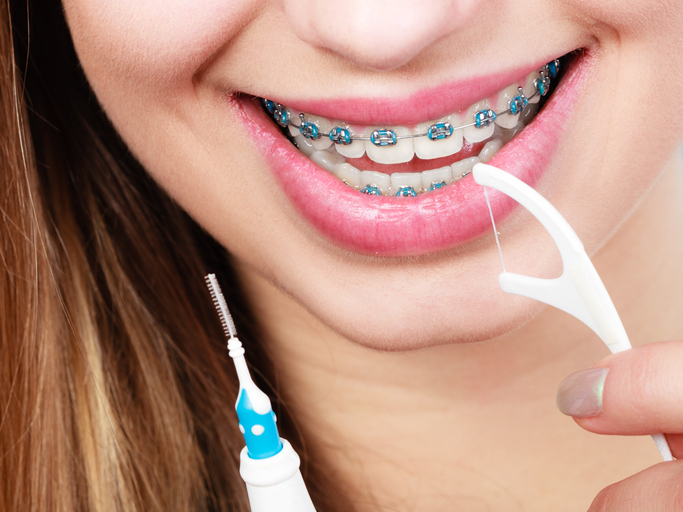A Guide to Flossing with Braces

January 22, 2019
If you have braces, then it is easy to become dissuaded from cleaning your teeth when you know it will take awhile. If you follow some of these tips, then you will be able to streamline your oral care routine, straighten your smile, and prevent unnecessary trips to the local dentist.
1. Maintain a healthy oral care routine
You have probably already discovered that braces make flossing more difficult. However, they also make it a lot more important. Having braces gives food even more places to hide. When it comes to cleaning food from your teeth and gums, your toothbrush alone cannot do the job. You need to thoroughly floss at least once a day, paying special attention to the areas between your braces and under the wires.
2. How to use traditional floss
The ADA suggests using dental floss once a day to clean between your teeth. You can use it before or after brushing, but remember to do it at least once a day to keep your oral hygiene in check. This type of floss is the most common and least expensive interdental cleaner, so it is a great way to save money in the long run by avoiding costly dental procedures due to poor oral care.
Using dental floss is pretty straightforward. Normally, you would hold the floss taut between your fingers and slide it between two teeth, but braces require threading the floss between the teeth and above the wire. Be gentle as you do this so you do not accidentally pop the floss into your gums, or damage your braces. Once you run up to the gumline, slide the floss gently around one tooth, and then slide it down while rubbing in small up and down motions. Once you finish, thread the floss through the next set of teeth and repeat.
Waxed dental floss is recommended for people who have braces since non-waxed floss can tear and get caught on them. This can be found in most convenience and grocery stores, but if you have trouble finding it, then ask your dentist about it.
3. Try a floss threader
Traditional dental floss takes awhile to use, but you can speed up the process with a dental threader. These are pretty inexpensive products that help you thread the floss between your teeth and the wires. Just pull a string of floss (around 18 inches) through the eye of the threader, and put the tip of the plastic needle under the wire of your braces. Pull the floss through and wrap it around your finger. This will give you more control over the floss and will keep it from slipping out of your grasp. Now you can use it just like traditional dental floss, sliding it up and down between your teeth. Once you finish, pull the floss out from behind the wire, rethread, and do the same for the next set of teeth.
4. Save time with an oral irrigator
If you cannot maintain these methods, then try an oral irrigator. These devices use a stream of water to remove plaque and food debris from your teeth, and they are great for people who might have a difficult time flossing by hand or between their braces. Using “water floss” is much faster than traditional dental floss, and the equipment is not too expensive. You can also buy special tapered tips to make flossing with braces easier.
Using water floss devices is pretty straightforward. Each device has a reservoir that you fill with water. You can even put diluted mouthwash in the reservoir if you want to use an antibacterial solution. You can attach different types of tapered edges to the top and eject water from them by pressing a button. You will want to lean over the sink, and loosely close your lips around the tip to make sure water does not splash around the counter while still keeping your lips parted enough for water to drain out as you floss. Simply glide the spray between your teeth and across your gum line to clean out the food particles.
5. Make flossing easier by watching what you eat
One of the most important tips for living with braces is what not to eat. Excessively chewy, sticky, or chunky foods can damage your braces, requiring you to take another trip to the dentist for a repair that could have been prevented. The major foods to avoid are chunky peanut butter, gummy candies, caramel, nuts, hard candies, corn on the cob, dried fruits, beef jerky, and chewing gum. A few other foods are only safe to eat if you chew them carefully. These include chips or other crunchy snacks, chewy bread, and fruits and vegetables. Just chew slowly, take little bits, and you will be good to go!
Sticky foods make flossing and brushing a very large undertaking, so it is best to avoid them. You will also want to limit eating starchy or sugary foods since they lead to plaque build-up on your braces. A cosmetic dentist can give you tips about keeping your braces clean. After all, getting into a proper oral cleaning routine can help you prevent cavities, gum disease, and give you the smile you always wanted!
For more information
If you’re looking for a cosmetic dentist, Little Rock has a lot to offer. Here at Arkansas Family Dental, we pride ourselves on our friendly staff and comforting environment. Going to the dentist doesn’t have to be scary! Give us a call at (501) 683-8886 to schedule an appointment or contact us here.
Connect With
Call (501) 232-6273 or request an appointment online to set up your first visit. We’ll be in touch soon.
